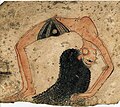Egizio Museum
The Museo Egizio in Turin ( Italian Museo delle antichità egizie di Torino ) is a museum that deals exclusively with Egyptology . The collection includes 32,500 artifacts , 6,500 of which are on display. It ranks ninth in the great collections of Egyptian ancient works. The museum's first director was Ernesto Schiaparelli , who had previously headed the Egyptian Museum in Florence .
renovation
The Museo Egizio in Via Accademia delle Scienze No. 6 is the oldest of its kind at almost 200 years and is considered to be one of the most important collections of ancient Egyptian art and culture outside of Cairo. After five years of renovation without interrupting the opening hours and costs of 50 million euros invested by the city of Turin, the museum was reopened on April 1, 2015 by Christian Greco . After Eleni Vassilika , he has been the new director of the museum since April 2014.
collection
The collection goes back, among other things, to acquisitions by Karl Felix , King of Sardinia-Piedmont . In 1824 he acquired 5,268 artifacts, including 100 statues and 170 papyri . Other pieces were purchased from Consul Bernardino Drovetti , a French collector of ancient Egyptian art. Schiaparelli's excavation activities expanded the holdings of the museum considerably.
The Egyptian Museum has an important papyrus collection. This contains a map of gold mines , the erotic Turin papyrus and, above all, the Turin royal papyrus , which the museum acquired in 1824. In terms of research history, the Turin 1791 Book of the Dead papyrus is of enormous importance because Karl Richard Lepsius based his first edition of the Book of the Dead on this particularly complete papyrus. Further highlights of the collection are the complete burial equipment of the architect Cha and his wife Merit from the 18th dynasty , numerous finds from the prince graves of Qaw el-Kebir ( 12th dynasty ), numerous finds from the Valley of the Queens and fragments of a shrine of Djoser from Heliopolis .
In 2012, renovation enabled an exhibition with 300 loans from Turin in the Palatinate History Museum in Speyer . Since then, information on the most important exhibits has also been available in a German-language catalog.
Illustrations
Sarcophagus Amenhotep II
Statue of Seti II
Still image of the Sekhmet
Statue of Ptah
Additions from the tomb of Cha ( TT8 ) and his wife Merit
Seated statue of Ramses II.
literature
- Wolfgang Kosack : Schenute by Atripe De judicio finale: Papyrus Code 63000.IV in the Museo Egizio di Torino. Introduction, text editing and translation edited by Wolfgang Kosack. Berlin 2013. Christoph Brunner, Basel 2013, ISBN 978-3-9524018-5-9 .
- Wolfgang Kosack: Basilios, De archangelo Michael, sahidice pseudo - Euhodios De resurrectione, sahidice pseudo - Euhodios De dormitione Mariae virginis, sahidice & bohairice: <Papyrus Code Turin, Mus. Egizio Cat. 63000 XI. > together with variants and fragments. Edited, commented and translated in parallel lines by Wolfgang Kosack Verlag Christoph Brunner Berlin 2014. New edition, Christoph Brunner, Basel 2014, ISBN 978-3-906206-02-8 .
- Historical Museum of the Palatinate : Discover Egypt's treasures. Masterpieces from the Egyptian Museum Turin. Prestel, Munich 2012, ISBN 978-3-7913-5192-6 .
See also
Web links
- www.museoegizio.it Official site
Individual evidence
- ^ Museo Egizio: The History of the Museum. ( Memento from March 23, 2015 in the Internet Archive )
- ^ Paul Kreiner: Museo Egizio in Turin. Signs warn: Attention, mummy! On: tagesspiegel.de from April 7, 2015; last accessed on September 15, 2015.
- ^ Museo Egizio: Curriculum vitae by Christian Greco. ( PDF file ( Memento of March 4, 2016 in the Internet Archive )) On: museoegizio.it ; accessed on September 15, 2015.
- ^ Richard Lepsius, The Egyptians' Book of the Dead based on the hieroglyphic papyrus in Turin. Georg Wigand, Leipzig 1842.
- ↑ Historical Museum of the Palatinate: Discover Egypt's treasures. Masterpieces from the Egyptian Museum Turin. Prestel, Munich 2012
Coordinates: 45 ° 4 ′ 6 ″ N , 7 ° 41 ′ 4 ″ E














